Address
304 North Cardinal St.
Dorchester Center, MA 02124
Work Hours
Monday to Friday: 7AM - 7PM
Weekend: 10AM - 5PM
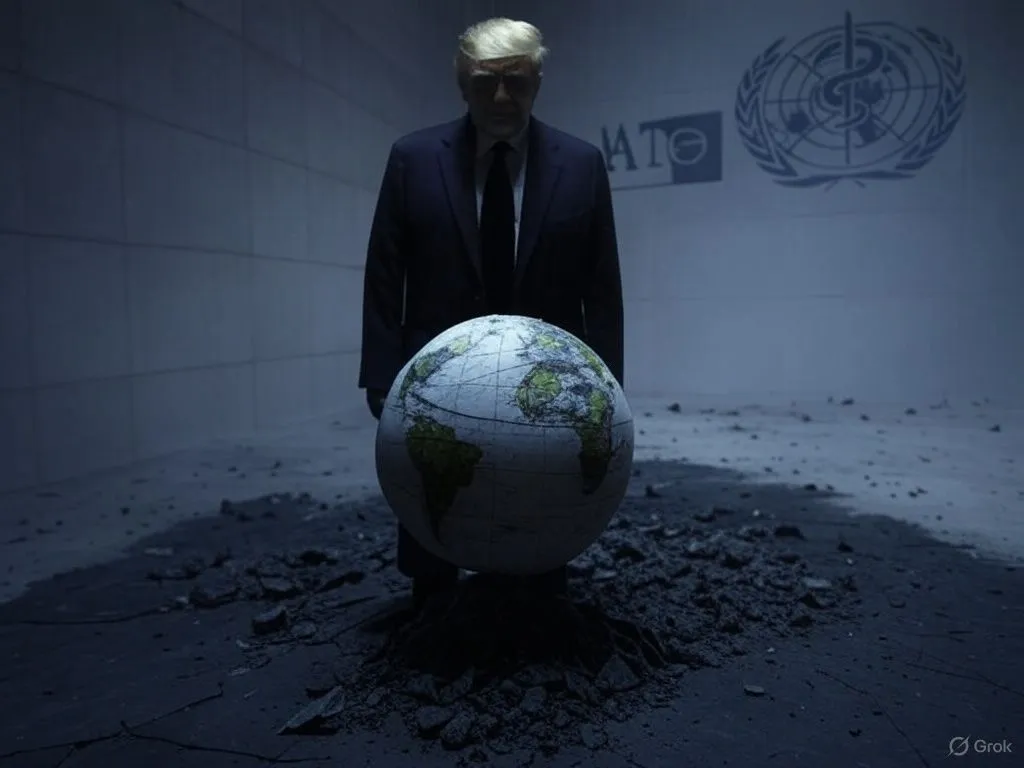
The so-called “Trump Doctrine” has often been mischaracterized as incoherent, improvisational, or purely reactive. In reality, it is one of the most brutally consistent strategic frameworks to emerge from a Western democracy in the 21st century. It is not a doctrine in the traditional sense—there is no grand strategy document, no formal theory, no Kissingerian balance-of-power playbook. Instead, it is a doctrine of destruction: of alliances, of norms, of institutions, of the very idea of partnership itself.
At its core, the Trump Doctrine is built on five interlocking pillars:
✔️ Transactional Sovereignty: Every alliance is negotiable, every treaty disposable. Loyalty is measured in tribute—military, financial, or rhetorical.
✔️ Dominance Over Diplomacy: Coercion replaces consensus. Treaties become ultimatums. International bodies are enemies unless fully controllable.
✔️ Narrative Supremacy: Foreign policy is performance. Strategy is subordinated to media optics, domestic political theatre, and personal branding.
✔️ The Erasure of Partnership: Multilateral institutions are not reformed—they’re dismantled. Cultural, academic, and scientific cooperation are seen as infiltration vectors.
✔️ Isolation as Strength: Borders are sacrosanct, not just physically but ideologically. Engagement with the world is viewed as weakness, unless it involves conquest, extraction, or humiliation.
These principles played out globally:
– NATO partners were threatened unless they “paid up.”
– Trade partners like Canada were hit with tariffs under national security pretenses.
– China was engaged through incoherent economic warfare, not diplomatic leverage.
– The WHO was abandoned during a global pandemic and subsequently withdrawn from – throwing the global health cooperation system into chaos.
– U.S. border policy became both literal and symbolic authoritarian theater.
Domestically, the same logic applied. Trump treated states, institutions, and journalists as adversaries unless they submitted unconditionally. Diplomacy abroad mirrored his governance at home: divide, dominate, and delegitimize.
What the Trump Doctrine accomplished was the redefinition of U.S. power away from leadership and toward extraction. It offered the world a vision of America not as an imperfect ally, but as an untrustworthy hegemon. A force to be endured, not partnered with.
This brief dissects that doctrine—its origins, mechanics, case studies, and likely trajectory should it return in 2025. Whether or not Trump holds office again, the system he broke will not heal easily. The world has already adapted. And it will not forget.
The Trump Doctrine may not be written down—but it has been deeply, strategically implemented.
And it’s still here.
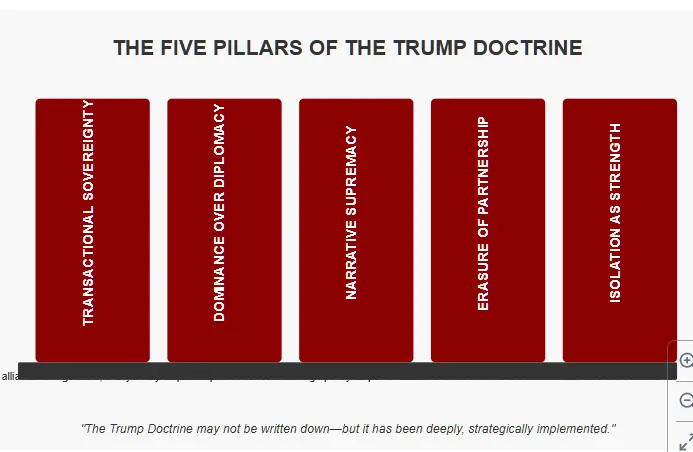
For much of Trump’s first term, mainstream analysts insisted there was no Trump Doctrine. This wasn’t entirely wrong—at least not in the traditional sense. There was no long white paper, no West Point speech with bullet-pointed tenets, no overarching narrative framework in the style of Truman, Eisenhower, or even Bush 43. What existed instead was chaos—loud, impulsive, often contradictory behavior that defied the structure of modern diplomacy.
But this was the mistake: assuming incoherence at the tactical level implied incoherence at the strategic one.
In truth, the lack of a doctrine was the doctrine. Trump’s foreign policy posture was designed to reject the very premise of predictability. It wasn’t formulated by academics—it was forged by instincts, vendettas, and cable news reactions. But that didn’t make it unprincipled. It made it anti-institutional by design.
The Trump Doctrine was never about building. It was about breaking. Breaking treaties, breaking alliances, breaking the post-WWII liberal order. And in that mission, it was ruthlessly consistent.
Where previous presidents saw diplomacy as a tool to stabilize or expand American influence, Trump saw it as a game to be rigged—or ignored. His genius wasn’t strategic depth. It was rhetorical sabotage, layered with just enough disruption to force every foreign counterpart into defensive recalibration.
That’s not a void. That’s a playbook.
Trump didn’t arrive with a doctrine because he didn’t need one. He was the doctrine. The unpredictability was the point. And by the time the foreign policy establishment figured it out, he had already redefined the rules.
If Trump was the doctrine, its infrastructure was built by a handful of ideologues operating on the fringes of mainstream policy—figures who translated gut-level grievance into structural sabotage. While Trump himself lacked ideological consistency, his inner circle supplied the operational language of disruption. Their influence cannot be overstated.
Chief among them was Steve Bannon, who injected a millenarian flavor into Trump’s nationalist instincts. For Bannon, the goal wasn’t mere electoral dominance—it was civilizational war against globalism, Islam, and the so-called “administrative state.” His fingerprints are all over early efforts to torpedo NATO, slash U.N. funding, and sever the State Department from career expertise.
Then came Stephen Miller, the author of some of the most xenophobic immigration policies in modern American history. Miller reframed foreign engagement as infiltration, casting refugees, immigrants, and even foreign students as vectors of cultural subversion. His obsession with sealing the border was never just about security—it was about identity preservation through exclusion.
Peter Navarro weaponized trade policy, embracing tariffs not as bargaining chips but as ideological instruments. For Navarro, free trade was treason. Multilateral agreements were surrender. His influence ensured that Trump’s economic war on allies like Canada, Germany, and South Korea was framed not as cost-benefit calculation, but as nationalist duty.
Even more transactional actors like John Bolton and Mike Pompeo reinforced the idea that international institutions were threats to American power, not guarantors of it. Their contributions helped institutionalize the idea that American sovereignty was incompatible with global cooperation.
Together, these figures created the doctrinal scaffolding for Trump’s instincts. They didn’t moderate him—they codified him. And in doing so, they helped birth a worldview that now lives on well beyond their tenure.
What began as improvisation calcified into infrastructure. Trump’s gut reactions—his hostility to alliances, his suspicion of foreign aid, his contempt for multilateralism—were initially dismissed as political theater. But over time, those impulses hardened into a durable operating system, replicated across departments, agencies, and diplomatic channels.
By the end of 2018, it was no longer possible to claim this was improvisation. Trump had purged or sidelined nearly every official who had attempted to maintain traditional foreign policy norms. Generals like Mattis, diplomats like Tillerson, and intelligence figures like Dan Coats were replaced with loyalists who understood the mission: destroy the architecture, and call it sovereignty.
The withdrawal from the Trans-Pacific Partnership (TPP) set the tone. This wasn’t about better trade terms—it was about pulling the plug on U.S. leadership in Asia to spite Obama-era multilateralism. Trump’s unilateral exit from the Paris Climate Accord followed the same logic: multilateral obligations were reframed as colonial burdens, shackling American dominance to foreign consensus.
The pattern was clear: dismantle, disrupt, delegitimize.
By the time COVID-19 struck, Trump had already pulled out of UNESCO, defunded the UN Population Fund, gutted the State Department, and signaled withdrawal from the World Health Organization. When the global crisis arrived, America had already burned its bridges—on purpose.
The Trump Doctrine didn’t emerge from a strategy document. It evolved organically, through purges, withdrawals, and permanent institutional sabotage. And what started as a tantrum became a framework.
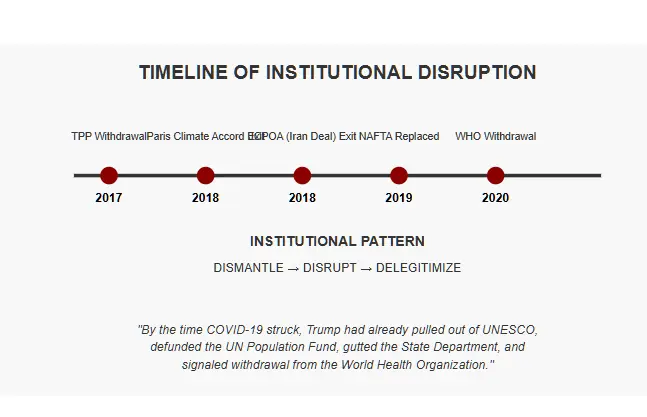
Trump’s worldview is built on one sacred principle: there are no allies, only transactions. Sovereignty is not shared. It is leveraged. Every interaction—diplomatic, military, economic—is a deal to be won or a liability to be dumped. Under the Trump Doctrine, international relations are stripped of any moral or historical weight and recast as pure exchange: tribute for access, submission for protection.
NATO became the first battlefield for this logic. Trump didn’t just demand increased defense spending from European members—he framed the alliance itself as a scam, accusing allies of freeloading off American military might. His administration openly discussed withdrawing from NATO unless countries “paid their bills,” as though a collective defense pact were a country club membership.
In Asia, the same pattern played out. Trump demanded that South Korea dramatically increase payments for the U.S. troop presence, threatening to pull forces if Seoul didn’t comply. Similar signals were sent to Japan. Defense was no longer framed as shared deterrence—it was military racketeering in the language of a balance sheet.
Multilateral trade agreements like NAFTA were dismantled and rebranded (as USMCA) not necessarily to improve terms, but to reassert dominance. The idea was clear: if America wasn’t being visibly prioritized, then the deal had to be burned down and replaced.
Even humanitarian aid became transactional. Funding to countries like Ukraine, El Salvador, and Pakistan was routinely threatened or withheld to extract political concessions—or in some cases, personal favors. Sovereignty, in this framework, was a one-way street: yours is negotiable; ours is not. While Trump acted widely in gutting USAID in 2025, because it was an inefficient cesspool of graft and corruption, he does not appear to have a meaningful game plan for future foreign aid delivery.
Under the Trump Doctrine, diplomacy isn’t dead. It’s just been downgraded to extortion.
Under the Trump Doctrine, diplomacy is no longer a tool of engagement—it is a subordinate instrument of dominance. The old model of negotiation—shared interests, mutual concessions, long-term alignment—is viewed as weak, even un-American. In its place is a preference for coercion, public humiliation, and unilateral declarations. If diplomacy is used at all, it is only in service of extracting visible submission.
Trump’s treatment of traditional allies reflects this shift. At G7 summits, he routinely insulted leaders behind closed doors and on camera, branding Canadian Prime Minister Justin Trudeau “weak” and German Chancellor Angela Merkel “very bad” for resisting his trade demands. When consensus couldn’t be enforced, the U.S. simply walked away, often without notice.
The Iran nuclear deal (JCPOA)—a multilateral diplomatic achievement supported by the EU, Russia, and China—was shredded not because of provable violations, but because it was multilateral and inherited. Trump’s withdrawal came with no plan to replace it, only a maximalist demand that Iran return to the table and capitulate. When it didn’t, sanctions were reimposed, diplomacy was frozen, and escalation followed.
Even peace summits became theatrical rituals of dominance. Trump’s meetings with North Korea’s Kim Jong-un were framed as breakthroughs but functioned as branding exercises. No real disarmament occurred. No verification agreements were signed. But Trump got the optics—flags, handshakes, strobes—and treated diplomacy as victory in itself, even without substance.
The underlying philosophy is clear: diplomacy is only valuable when it ends with a photo, a signature, or a concession. Otherwise, it’s a waste of time.
In the Trump Doctrine, diplomacy is not a process. It’s a performance with a winner. And if there isn’t one, he walks off stage.
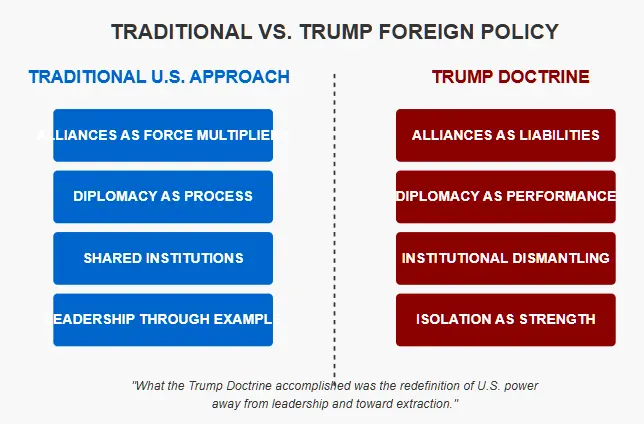
If there is one defining feature of the Trump Doctrine, it is the total subordination of policy to narrative. Strategy becomes irrelevant if it doesn’t play well on television. Alliances are disposable if they don’t produce immediate optics. Foreign policy is no longer a statecraft exercise—it is domestic theater projected outward, with the world reduced to a supporting cast in America’s internal drama.
Trump doesn’t govern by doctrine. He governs by control of the frame. Who is strong? Who is weak? Who bowed? Who clapped? Who made him look bad? These are the metrics that matter. Traditional foreign policy institutions—State, Defense, Intelligence—are too slow, too procedural, too “elite” to serve that frame. So they are bypassed. The battlefield becomes cable news, social media, and press conferences. Speed trumps accuracy. Spectacle trumps outcome.
This is how foreign summits become pro-wrestling entrances, how North Korea becomes a photo-op, and how the G7 becomes a humiliation exercise. Facts are immaterial. What matters is who looked dominant, who “won,” and whether the base cheered.
The same narrative supremacy governs threat construction. China is a villain because it’s economically competitive. Canada becomes a problem because it refuses to grovel. Institutions like the WHO are cast as globalist stooges not based on policy failures, but on how easily they can be framed as anti-American.
Diplomacy that doesn’t serve the story is discarded. Treaties that contradict the script are rewritten—or torched. Truth becomes malleable. What matters is who’s controlling the chyron.
The Trump Doctrine doesn’t just abandon reality. It conquers it, using narrative as a sovereign weapon.
The Trump Doctrine does not merely downplay partnership—it seeks to erase the very concept of it. Where previous administrations maintained alliances as strategic force multipliers, Trump viewed them as constraints—obligations that diluted American power and forced unwanted compromise. In his worldview, cooperation is code for weakness; compromise is capitulation.
This erasure is not confined to military alliances or trade agreements. It extends to soft power structures—the cultural, educational, and humanitarian programs that once underpinned U.S. influence abroad. From the gutting of the Fulbright Program to the withdrawal from UNESCO and the UN Human Rights Council, Trump’s administration systematically dismantled the connective tissue of international engagement.
Foreign aid was recast as extortion. Peacekeeping was reframed as wasted resources. Even USAID, a historically bipartisan agency, despite its reputation for contractor corruption, came under pressure to tie every dollar to domestic political gain and was then gutted. The goal was clear: no more giving without submission. No more sharing without advantage.
Even long-standing bilateral relationships were deliberately degraded. Canada, once America’s most stable partner, was hit with steel and aluminum tariffs under the absurd pretense of being a “national security threat.” South Korea was threatened with troop withdrawals. Germany was painted as an enemy despite decades of NATO leadership. Partnership, under Trump, was either obedience—or betrayal.
The diplomatic result? Isolation by design. Multilateralism was gutted. Cooperation was redefined as loss. And where American influence once flowed through networks of trust, it now lurched through acts of transactional dominance—or not at all.
In erasing partnership, the Trump Doctrine didn’t simply break alliances. It reprogrammed America’s diplomatic muscle memory, leaving allies unsure whether the United States could ever be trusted again—even after Trump.
At the heart of the Trump Doctrine lies a radical inversion of post-WWII U.S. strategy: isolation is not a threat—it is the goal. Where earlier generations of American policymakers saw engagement, integration, and global presence as vital to national power, Trump reimagined disengagement as strength. Every treaty torn, every door closed, every agency defunded was framed as a victory for sovereignty.
This logic played out most visibly in immigration. The border wall was never just infrastructure—it was ideology made concrete. The administration’s obsession with separation, detainment, and exclusion extended beyond undocumented migrants to refugees, asylum seekers, and even foreign students. The message was unmistakable: America is a fortress, not a sanctuary.
But this wasn’t limited to people. Trump’s withdrawal from the World Health Organization during a pandemic wasn’t an error in judgment—it was a deliberate move to sever global accountability. The same applied to pulling out of climate agreements, arms control treaties, and pandemic response pacts. In each case, the action was less about policy specifics and more about symbolism: we don’t need you.
The consequence was a self-imposed shrinking of the American sphere. Soft power was gutted. Influence waned. Allies began making plans without Washington, hedging bets, or pivoting toward regional alternatives. Yet for Trump and his circle, this wasn’t failure—it was liberation.
The Trump Doctrine sold isolation as strength not despite its costs, but because of them. Alienation proved purity. Decoupling meant control. Engagement was for the weak. And if the world became more chaotic in America’s absence, that was simply confirmation that the world needed to fall in line—or be ignored.
Under Trump, isolation wasn’t accidental. It was the reward.
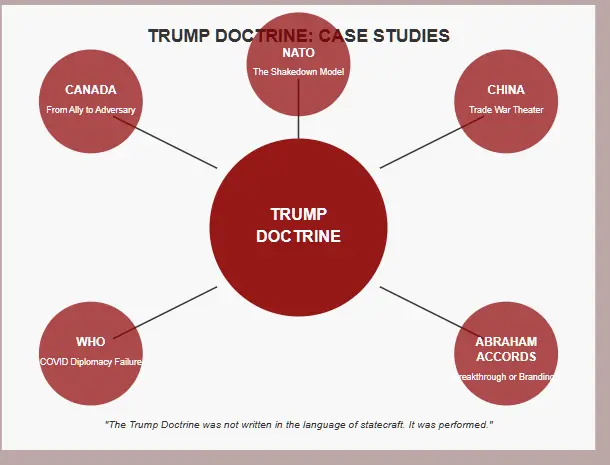
The most visible rupture came via tariffs on Canadian steel and aluminum, imposed under the bizarre claim that Canada posed a national security threat. This was not a negotiating tactic—it was a strategic message. If even Canada could be framed as a danger, then no alliance was safe, no treaty sacred, no friendship guaranteed. The North American Free Trade Agreement (NAFTA) was scrapped and rebranded under the USMCA, not because its replacement was superior, but because the very existence of a trilateral deal violated the Trumpian instinct to dominate bilaterally.
Canada’s role as a cultural and diplomatic ally was also redefined. Trump repeatedly humiliated Prime Minister Trudeau on the world stage, mocking him as “two-faced,” “weak,” and “dishonest.” These weren’t offhand insults. They were part of a broader pattern of ally degradation—a rhetorical erosion designed to fracture public trust in cross-border relations.
Canada wasn’t attacked for anything it did. It was targeted for what it represented: continuity, trust, and partnership. Under the Trump Doctrine, those values were liabilities.
By making an enemy of its closest ally, the United States sent a message to the rest of the world: if Canada isn’t safe, no one is.
Nowhere was the Trump Doctrine’s hostility to partnership more visible—or more dangerous—than in its treatment of NATO. For over 70 years, the alliance served as the cornerstone of Western security and a deterrent against Russian aggression. But to Trump, NATO was neither sacred nor strategic. It was a protection racket, and allies were deadbeats.
From his first G7 and NATO summits onward, Trump treated European partners less like allies and more like delinquent clients. He publicly shamed Germany for underpaying its “dues,” demanded that NATO members meet arbitrary spending targets, and suggested the U.S. might not uphold Article 5, the mutual defense clause—effectively nullifying the alliance’s deterrent value. In private, he reportedly told aides he wanted to withdraw from NATO entirely.
This wasn’t a negotiating tactic. It was a core belief: that American military support should only be extended if directly profitable, and that Europe’s security was Europe’s problem. His administration moved to withdraw thousands of troops from Germany, not for strategic repositioning, but as punishment for perceived disrespect. The policy rationale was incoherent—the political signal was not: loyalty is now conditional.
Even beyond NATO, traditional alliances were disrupted. The EU was recast as an “enemy” in trade terms. France and Germany were targeted rhetorically. The idea of a “shared West” was replaced by bilateral power games, with Trump openly admiring authoritarian leaders like Viktor Orbán while undermining liberal democracies.
The broader message to Europe was chilling: the U.S. no longer views itself as the guarantor of order, but the enforcer of compliance. Trust was replaced with leverage. Deterrence was replaced with doubt.
For Russia, the payoff was obvious: a weakened NATO, divided allies, and a power vacuum in transatlantic leadership. For Europe, the Trump era served as a strategic wake-up call—one they may not survive twice.
Trump’s approach to China was framed as tough, disruptive, and long overdue. In reality, it was chaotic, superficial, and performative—a trade war dressed up as grand strategy, designed more for Fox News clips than economic rebalancing or geopolitical containment.
On the surface, Trump did what many American politicians only threatened: he slapped billions in tariffs on Chinese goods, accused Beijing of intellectual property theft, and launched an economic confrontation that dominated headlines for two years. But behind the bluster, the execution was hollow.
Tariffs were applied without coordination, frequently reversed, and often hurt American farmers, manufacturers, and consumers more than their Chinese counterparts. The administration’s messaging shifted weekly—sometimes daily—oscillating between threats, walk-backs, and vague claims of progress. Phase One of the trade deal, Trump’s supposed victory lap, produced few structural changes, limited enforcement mechanisms, and no resolution to the underlying disputes.
The Trump Doctrine’s obsession with dominance over coherence meant that even as the administration escalated tensions, it failed to coordinate with allies in Europe, Asia, or Latin America who shared concerns about China’s rise. This squandered a rare moment of multilateral alignment and instead handed Beijing an opportunity to portray the U.S. as erratic and unreliable.
Worse, Trump’s personal admiration for Xi Jinping—calling him a “great leader” and “very smart”—undermined his own narrative. During the early days of COVID-19, Trump praised China’s response even as intelligence agencies warned of deception. Only later, when domestic pressure mounted, did he pivot to branding it the “China Virus,” further collapsing any chance at meaningful diplomacy or containment.
In the end, Trump’s trade war with China wasn’t a strategy. It was a reality show with no season finale. The confrontation looked dramatic, but it lacked structure, follow-through, or outcome. All spectacle. No leverage. And no plan.
If the Trump Doctrine sought to isolate the United States from global institutions, the COVID-19 pandemic provided the perfect crucible—and the World Health Organization (WHO) became the perfect scapegoat. In the midst of a once-in-a-century global crisis, Trump didn’t just mismanage America’s internal response; he withdrew from the planet.
The WHO was accused of being “China-centric,” of hiding the pandemic’s severity, and of failing to issue early warnings. Some of these critiques weren’t unfounded—but Trump’s decision to withdraw funding and initiate a formal exit from the organization during the height of the pandemic was not about reform. It was a symbolic act of abandonment, calibrated to deflect blame and reinforce the narrative that international cooperation is inherently corrupt or compromised.
The consequences were immediate. The U.S., which had long been the WHO’s largest donor, abdicated its leadership role in global health governance. Efforts to coordinate vaccine research, distribute medical supplies, and establish joint epidemiological standards were undercut. American scientists were sidelined. Trust in U.S. data collapsed. Global coordination fractured.
More damning, the Trump administration refused to join COVAX, the international effort to ensure equitable vaccine distribution. Instead, it pursued a nationalist hoarding strategy—“America First” even in death tolls—buying up early vaccine stock and treating medical aid as a transactional tool rather than a humanitarian obligation.
All of this unfolded as Trump spread disinformation at home: pushing hydroxychloroquine, suggesting bleach injections, and mocking masks. His White House became a viral cluster. Public health became partisan warfare. And science was treated as globalist treason.
The decision to abandon the WHO wasn’t just a policy failure—it was a doctrinal confirmation: America will not lead, will not help, and will not cooperate unless it controls the entire narrative. Even in a pandemic.
The Abraham Accords were hailed by the Trump administration as a historic diplomatic triumph—normalizing relations between Israel and several Arab states, including the United Arab Emirates, Bahrain, Morocco, and Sudan. On paper, the agreements were significant: they marked the first meaningful thaw in Arab-Israeli relations since the mid-1990s. But the reality beneath the optics was more complicated.
First, the Accords were not born from mutual resolution of conflict. They were brokered through incentives and leverage: weapons sales to the UAE, recognition of Moroccan sovereignty over Western Sahara, and promises of sanctions relief or aid to Sudan. These were transactions, not reconciliations—alliances of convenience structured around U.S. side deals, not regional trust.
Second, the Accords bypassed the Palestinians entirely. The core conflict that has defined Middle Eastern geopolitics for decades was simply edited out of the narrative. Trump’s administration had already severed ties with Palestinian leadership, moved the U.S. Embassy to Jerusalem, and cut funding to UNRWA. The Abraham Accords completed that erasure, reframing peace as a branding opportunity rather than a substantive breakthrough.
In true Trump Doctrine fashion, the Accords were treated less as a strategic achievement and more as a media campaign. The White House hosted a signing ceremony like a reality TV finale. Press releases used terms like “visionary leadership” and “historic deal” while downplaying the fact that these countries had never been in direct conflict with Israel to begin with.
That doesn’t mean the Accords are irrelevant—but they are deeply fragile. Without public buy-in, regional legitimacy, or Palestinian inclusion, they risk being seen as unsustainable elite pacts, vulnerable to regime change and populist backlash.
The Abraham Accords showed that Trump could still “do diplomacy”—but only when it looked like a trophy. Not a process. Not a peace. Just a photo.
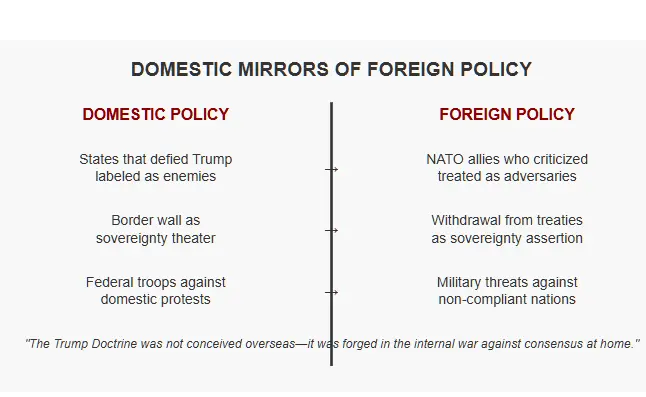
The Trump Doctrine was not conceived overseas—it was forged in the internal war against consensus at home. Trump’s foreign policy wasn’t a separate sphere; it was an extension of his domestic playbook. The same rhetorical tools used to delegitimize journalists, judges, and blue states were deployed abroad to fracture alliances and discredit international institutions.
States that defied him—California, New York, Washington—were rhetorically framed as enemies, much like NATO allies or trade partners. Sanctuary cities were treated as insurgent zones. Governors were mocked as incompetent foreign leaders. In Trump’s America, internal dissent was recoded as geopolitical betrayal.
That logic carried over to diplomacy. Foreign leaders who praised Trump were elevated. Those who criticized him were punished. And in both realms, the message was clear: loyalty to Trump, not to the country, was the measure of legitimacy.
Nowhere was the convergence of domestic and foreign “threats” more explicit than in immigration policy. The border wall wasn’t just a physical barrier—it was a foundational icon of the Trump Doctrine, turning U.S. soil into a frontline of sovereignty theater.
Immigrants were cast not as individuals but as vectors of infiltration—disease, crime, ideology. Refugees and asylum seekers were reframed as enemies until proven otherwise. The Muslim Ban, family separation, and “Remain in Mexico” policies weren’t isolated tactics; they were signals to the base that America was under siege.
Foreigners, like journalists and opposition politicians, became props in Trump’s narrative of betrayal. From ICE raids to CBP seizures of phones at the border, migration was weaponized as a test of national purity—and loyalty.
The authoritarian impulses that shaped Trump’s foreign posture were beta-tested on domestic ground. The use of federal troops to suppress protests, threats to invoke the Insurrection Act, and routine undermining of electoral integrity all mirrored the zero-sum dominance strategies deployed abroad.
Trump’s governing style—loyalty enforcement, elite purging, narrative warfare—was functionally indistinguishable from his foreign policy instinct. This is why diplomats were blindsided by his decisions: they weren’t made in embassies or situation rooms. They were made in front of cameras, on impulse, to reinforce a domestic spectacle.
The Trump Doctrine doesn’t differentiate between internal and external enemies. It treats all threats the same way: delegitimize, humiliate, isolate, punish. It’s not a theory of international relations. It’s a projection of domestic authoritarianism onto the world stage.
The Trump Doctrine is no longer a theoretical disruption. It is a stress test the world failed—a template for authoritarian posturing wrapped in the flag of national interest. As the United States barrels toward another potential Trump presidency in 2025, the central question is no longer whether the doctrine is coherent, but whether the global system can survive its full reimplementation.
In the context of this second Trump term, it is unlikely that it will be a repeat of the first—it will be accelerated, purged of friction, and strategically vengeful. The institutional resistance that limited parts of his first term has been weakened. The bureaucrats are gone. The loyalists are ready.
U.S. exit from the United Nations and its sub-orgs (like WHO, UNHRC, and potentially even the WTO) becomes likely—not necessarily through formal withdrawal, but by sustained defunding, legal non-cooperation, and policy sabotage.
Immigration enforcement becomes militarized. Expect expanded detention powers under the Alien Enemies Act, mass surveillance at borders, and the collapse of refugee pipelines.
In foreign relations, Trump 2.0 will formalize the turn toward autocratic alignment—strengthening ties with Orbán, Modi, Netanyahu, and others who validate the rhetoric of nationalist control. Taiwan, Ukraine, and Baltic states may be deprioritized in favor of bilateral deal-making that sells security as a subscription service.
Even if Trump does not return, the damage is done. U.S. foreign policy credibility has been structurally degraded. Allies are no longer assuming continuity—they’re preparing for whiplash. France, Germany, and Canada have already begun diversifying alliances. South Korea and Japan have hedged with China. The trust buffer is gone.
The deeper risk is that Trump’s instincts have now become normalized. A future president may reject Trump’s rhetoric but inherit his toolkit: unilateralism, coercive diplomacy, and suspicion of multilateral constraints.
No one is waiting for America to lead anymore. They are waiting to see if it collapses—or turns inward for good.
For years, commentators mocked the idea of a Trump Doctrine. They called it erratic, incoherent, or nonexistent—a blur of tweets and tantrums rather than any kind of strategic design. But this was a failure of imagination. The doctrine was always there. It just didn’t speak in white papers. It spoke in withdrawals, insults, purges, and broken treaties.
The Trump Doctrine was not written in the language of statecraft. It was performed. It didn’t build—it dismantled. It didn’t seek peace—it demanded submission. And it didn’t care for legacy or norms. It viewed both as obstacles.
What made it powerful wasn’t its intellectual rigor—it had none. What made it strategically lethal was its clarity of instinct: dominate the narrative, destroy constraints, punish dependency, and isolate the United States from anything it cannot control.
Alliances were liabilities. Multilateralism was treason. Diplomacy was weakness unless it ended in conquest. And even when Trump left office, the doctrine remained embedded in the structure: in gutted institutions, shattered trust, and the lingering suspicion that America could turn on its allies at any moment.
It is tempting to think of the Trump Doctrine as a detour. It wasn’t. It was a mirror held up to the fragility of the international system—and to America’s own democratic vulnerabilities.
It was the doctrine that wasn’t—until it was. And if it returns, it won’t need a second chance to finish the job. The world has already adjusted.
They won’t forget. And they won’t wait.
Because even if Trump goes away, his doctrine now lives inside the walls.
[…] the heart of this shift is the Trump-Vance-Hegseth Doctrine: a blunt-force return to hard power, with little interest in multilateralism, strategic ambiguity, […]
[…] the spring of 2025, Donald J. Trump — now returned to the presidency with a vengeance — declared that Federal Reserve Chair Jerome Powell’s “termination cannot come fast […]
[…] With Donald Trump back in the White House for a second term, U.S. foreign policy has entered a new p… Institutions that once gave Ottawa predictable cover—NATO, the UN, the G7—are increasingly paralyzed or irrelevant. […]
[…] threats (a “crime epidemic” or a “drug invasion”) to justify extraordinary powers, Trump is asserting that his authority defines the exception. America is now living in that exception. As one human rights watchdog observed two weeks ago, “President Donald Trump’s use of the […]
[…] (ATI) announced in 2025 during the beginning of the second Trump Administration, and in line with the Trump Doctrine, calls for eliminating “unnecessary programs” to “ruthlessly prioritize fighting formations […]
[…] is to bolster national pride and reclaim American “greatness” in nomenclature in line with the Trump Doctrine more broadly. In the words of Rep. Greene, Americans “deserve pride in the waters that we own, […]
[…] will want to settle quietly to avoid fueling nationalist ire at home. President Trump, in line with the Trump Doctrine, may use the crash as rhetorical ammunition but it is unlikely to lead to meaningful […]
[…] observe if any European leader reaches out to President Trump in relation to this matter or the Trump Doctrine more broadly – any such communication could indicate a push to restrain further U.S. action. In […]